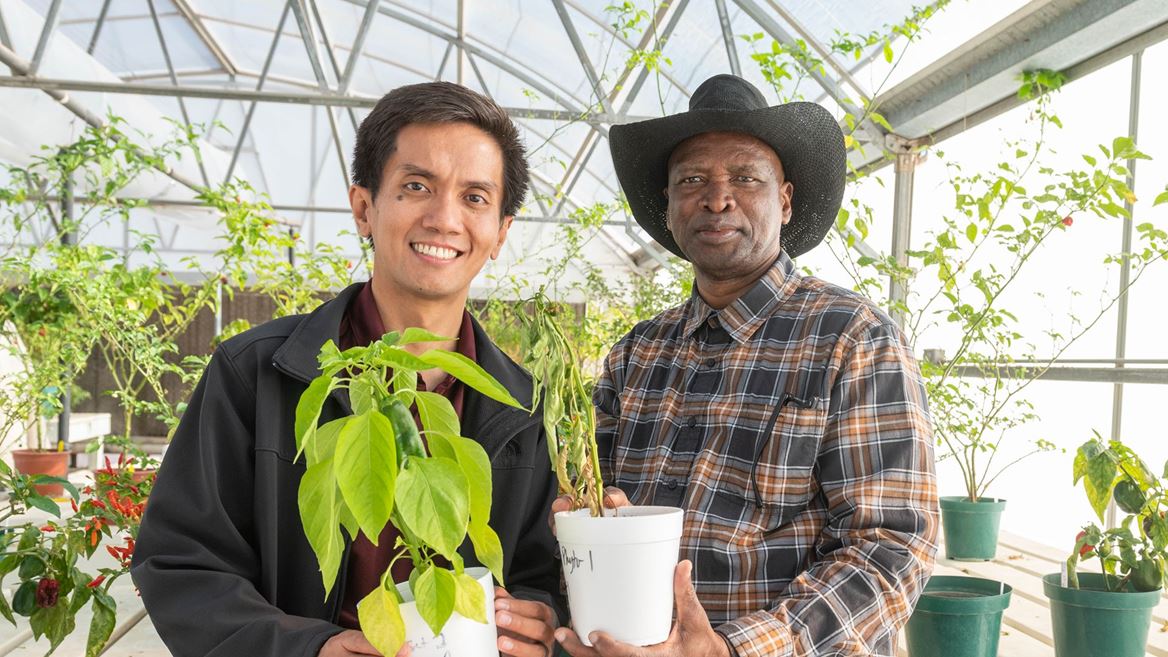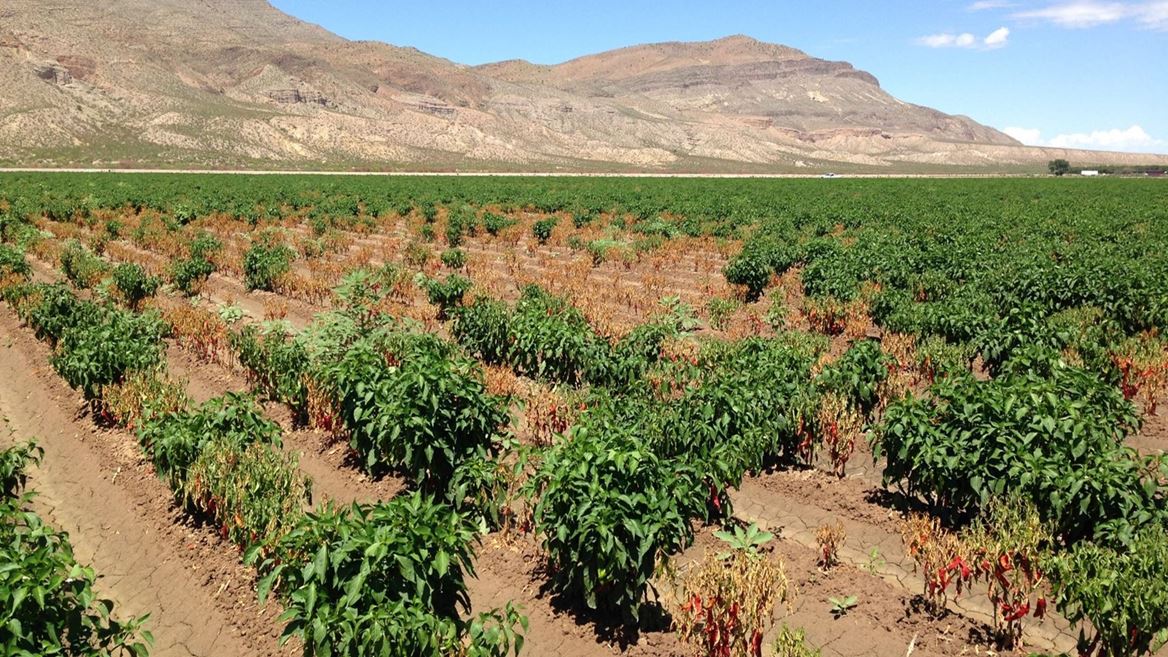New Mexico, USA
December 21, 2022

Dennis Nicuh Lozada, left, and Soum Sanogo at New Mexico State University’s Fabián García Science Center in Las Cruces. Sanogo, a professor of fungal plant pathology at NMSU, and Lozada, NMSU’s chile pepper breeder and director of the Chile Pepper Breeding and Genetics Program, collaborated on a paper examining the history of Phytophthora capsici, a soilborne microorganism that causes “chile wilt.” (NMSU photo by Josh Bachman)
A century ago, an assistant biologist at what is now known as New Mexico State University discovered a novel pathogen that posed a significant threat to the state’s budding chile pepper industry, kickstarting decades of critical research to understand and combat the disease.
Leon Hatchig Leonian, an internationally renowned researcher known for his work in plant diseases, plant breeding, and fungi physiology, first described Phytophthora capsici, a soilborne microorganism that causes “chile wilt,” in September 1922 during his tenure at New Mexico College of Agriculture and Mechanic Arts, now NMSU.
P. capsici infects plants and causes rotting in roots, stem, foliage, and fruit. It is common among peppers, tomatoes, and gourds – and can destroy entire crops.
In the years since Leonian’s discovery, NMSU has become a leader in advancing the scientific understanding of P. capsici.
“Numerous scientists have made tremendous progress in increasing our knowledge of this soil pathogen, but NMSU researchers take the reins,” said Soum Sanogo, a professor of fungal plant pathology at NMSU.
 A chile pepper field with high levels of Phytophthora capsica. The pathogen infects plants and causes rotting in roots, stem, foliage, and fruit. It is common among peppers, tomatoes, and gourds – and can destroy entire crops. (Coutesy)
A chile pepper field with high levels of Phytophthora capsica. The pathogen infects plants and causes rotting in roots, stem, foliage, and fruit. It is common among peppers, tomatoes, and gourds – and can destroy entire crops. (Coutesy)
To mark the 100th anniversary of P. capsici, Sanogo co-authored a paper on key research milestones in the pathogen’s history with a team of scientists from Arizona, Georgia, Illinois, Michigan, New Jersey, New York, Ohio, North Carolina, South Carolina, Tennessee, and Texas.
“Our collective efforts within and outside the United States have helped us understand how the environment affects the survival and spread of this pathogen,” Sanogo said. “We’ve also unlocked its genetics and learned how to best manage it through irrigation, crop rotation, and chemical and non-chemical practices.”
Yet, despite all the advances, researchers have not been successful in identifying a single treatment that can successfully control P. capsici on its own.
That’s why Sanogo and others at NMSU remain committed to studying the pathogen.
Sanogo, who leads NMSU’s Soilborne Disease Research Program, works closely with NMSU’s chile pepper breeder, Dennis Nicuh Lozada, who directs the Chile Pepper Breeding and Genetics Program, on research related to P. capsici. Lozada also contributed to the paper, published last month in the journal Phytopathology.
“We’ve been working closely with Dr. Sanogo’s lab on identifying cultivars or varieties that can potentially be good sources of resistance to Phytophthora capsici,” Lozada said.
Lozada said NMSU has four or five active projects examining the pathogen. The goal, he said, is to develop sustainable methods to combat P. capsici using beneficial microorganisms, agricultural byproducts, and genetic resistance.
For example, NMSU researchers have discovered that pecan byproducts – shells and husks – can help boost P. capsici resistance in chile peppers.
Sanogo also noted that jalapeño peppers are less susceptible to the pathogen. He added that current research is underway examining the feasibility of using jalapeños to “clean” – or remove – P. capsici from contaminated soils in chile pepper fields.
Much like other diseases, P. capsici mutates over time and unleashes variants, making it difficult to control, Sanogo said.
“It’s almost like the COVID-19 situation we see today. The pathogen has a lot of variants,” he said. “We’re collaborating with Dr. Lozada’s lab to see how we can identify those variants.”
Today, Sanogo said the most-asked question he receives from chile producers is whether he’s found a solution to fight P. capsici. In his response, he cautions that no single solution may emerge, given the pathogen’s evolving nature.
“I tell them if it was a simple solution, Dr. Fabián García would’ve found it many years ago,” he said, referring to the pioneering researcher who conducted groundbreaking chile research at NMSU more than a century ago. “But we think genetic resistance — if it is found — will be a game-changer.”
Working with chile pepper DNA, Lozada uses genomic tools to find genes related or associated with P. capsiciresistance. He said getting the correct genetic information can result in more informed breeding and selection decisions to develop chile cultivars resistant to the pathogen.
Lozada said over the next 100 years, it will be critical for researchers to use all available tools to fight P. capsica.
“The genetics and management teams need to work together to develop a pathogen-resistant cultivar,” he said. “It’s going to be challenging. But now is the time to build more collaborations and partnerships between breeders, pathologists, and other experts to work together to deal with the issue of P. capsici affecting chile pepper production in New Mexico.”
To read the paper, visit https://nmsu.news/chile-pepper-wilt-disease.